Do you struggle to enjoy quality time with your kids due to the shooting pain caused by sciatica? Is sciatica limiting your daily activities? Many people try to power through pain, self-diagnosis, or self-medicate, but this approach can be dangerous. Fortunately, relief is possible through safe and beneficial yoga for sciatica pain.
According to a recent study, practicing sciatica relief yoga can help alleviate pain and discomfort associated with non-specific lower back pain (LBP) as well as disc extrusions and bulges. In this article, we will introduce you to the nine best yoga asanas for sciatica relief and some simple sciatica exercises that may help you stretch your way to sciatica relief and prevention.
What is the sciatica nerve?
The sciatic nerve is the longest and widest nerve in the body and is as thick as your little finger. It runs from the lower lumbar spine to the sole of your feet. The sciatic nerve controls many muscles in the legs and provides sensation to the thighs, feet, and legs.
What is sciatica pain?
Sciatica pain refers to pain that originates from the lower back and travels through the buttock and down the leg. It is caused by the compression or irritation of the sciatic nerve.
Sciatica can cause varying degrees of pain ranging from mild to severe. The pain usually affects only one side of the body and may present as a mild and nagging pain or an unbearable shooting pain. The sensations could include throbbing pain, heat, soreness, tingling and even electric shock. These symptoms can make standing or walking difficult.
It is important to understand that not all lower back pain is due to sciatica. Only if your pain arises because of the affected sciatic nerve, it is called sciatica.
Common sciatica causes
Sciatica is often caused by compressed nerve fibre, herniated disc, spinal stenosis, osteoarthritis, or degenerative disc disease. Other factors include smoking, obesity, and prolonged sitting or standing.
But don’t worry. Relief can happen through sciatica yoga.
Yoga for sciatica pain relief
- Shishuasana (Child pose)
- Setu Bandhasana (Bridge pose)
- Viparit Karani (Legs-up-the-wall pose)
- Pawanmuktasana (Wind-relieving pose)
- Supta Kapotasana (Reclined pigeon pose)
- Adho Mukha Svanasana (Downward-facing dog pose)
- Eka Pada Raja Kapotasana (One-legged pigeon pose)
- Ardha Matsyendrasana (Sitting half spinal twist)
- Gomukhasana (Cow face pose)
1. Shishuasana (Child pose)
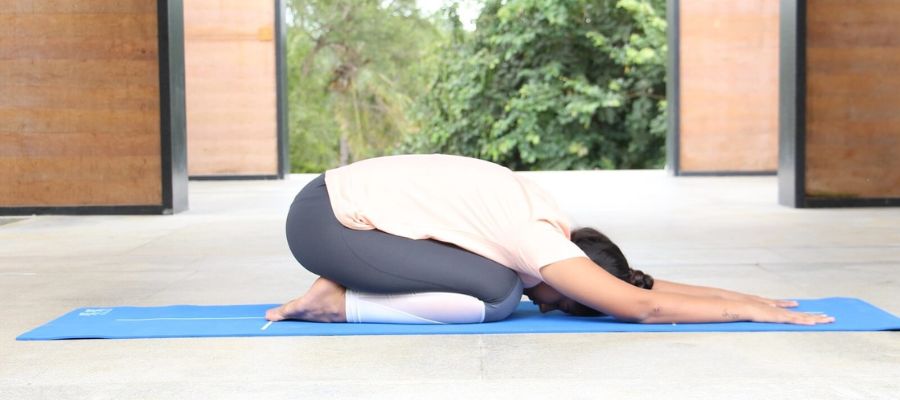
Read this for steps to practice of Shishuasana.
Benefits:
- Relieves sciatic pain
- Stretches spine and hips
- Calms nervous system
Aim: Focus on relaxing the body, releasing tension in the hips, thighs, and lower back.
Tips: You may pull your navel in while bending forward for ease in bending or use props or cushions under your thighs, chest, and forehead.
2. Setu Bandhasana (Bridge pose)
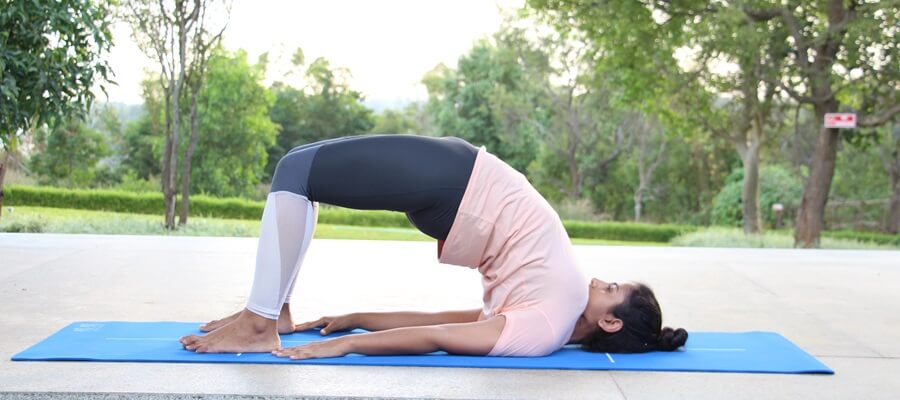
Read this for steps to practice the Setubandhasana.
Benefits:
- Opens and stretches the hip flexors
- Strengthens the core and back muscles
- Relieves lower back pain
Aim: Align your back, root, and thighs in a straight line and maintain it for about 10 seconds, gradually increasing the length of the pose.
Tip: You may support your lower back with your hands if that is comfortable for you.
3. Viparita Karani (Legs-up-the-wall pose)
Benefits:
- Relieves tired legs and feet
- Relaxes the hips and back
- Reduces knee and ankle pain, as you take your body weight off your knee
Aim: As your body gets a deep rest, try to relax your mind likewise.
Tip: To add to your comfort, place a hip bolster under your hips to support it.
4. Pawan Muktasana (Wind-relieving pose)
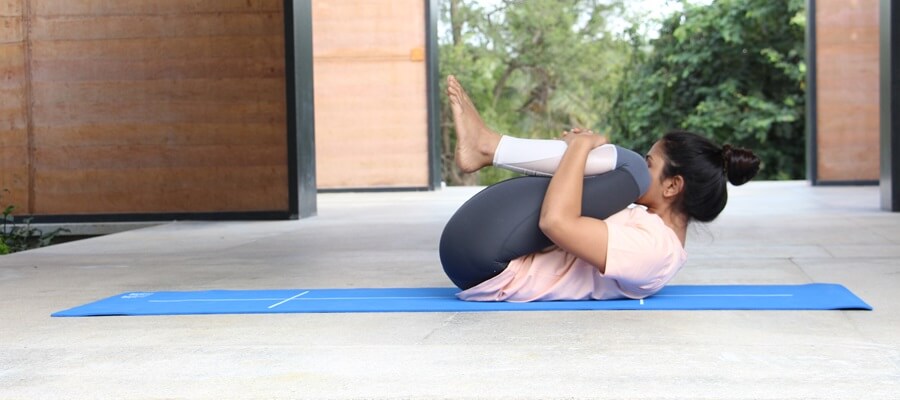
Read this for steps to practice the Pawanmuktasana.
Benefits:
- Helps flex your back and hip muscles
- Loosens the tightness in the lower back
- Relieves knee pain
Aim: Maintain the pose for as long as you are comfortable; the bend will relieve weariness.
Tips: If you are not comfortable with this pose, don’t lift your head. Practice the asana with one leg bent, instead of bending both legs together.
5. Supta Kapotasana (Reclined pigeon pose)
Benefits:
- Relieves sciatic pain
- Stretches hips and glutes to make them flexible
- Relaxes the body
Aim: Focus on breathing deeply, relaxing the body, and gently stretching the hips and glutes.
Tips: Practice with awareness, avoid overstretching and use props if needed.
If you can practice this asana with comfort, the next level is Eka Pada Raja Kapotasana. Or else, you may skip it.
6. Adho Mukha Svanasana (Downward-facing dog pose)
Read this for steps to practice the Adho mukh svanasana.
Benefits:
- Helps stretch and tone the back muscles
- Strengthens the legs and feet
- Lengthens the spine
Aim: Move the heels towards the floor, touching it if possible. The idea is to shift the weight off the back onto the heels.
Tip: Do some warm-up exercises for the ankles and arms before you get into this pose, as they manage the weight of your body in this pose.
7. Eka Pada Raja Kapotasana (One-legged pigeon pose)
Read this for steps to practice the asana.
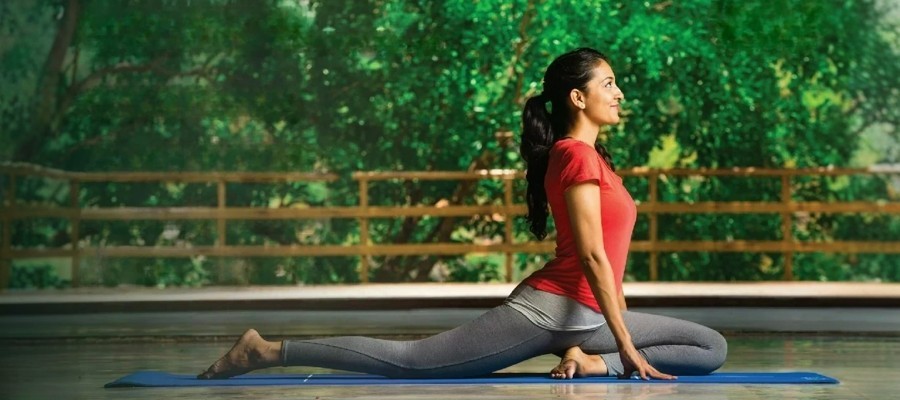
Benefits: Benefits of Eka Pada Raja Kapotasana as below.
- Stretches the lower part of your body well, relieving aching muscles
- Makes the hip region more flexible
- Promotes good posture
Aim: Focus on balancing your body and once that is achieved, feeling calm.
Tip: Focus on both hips even if there is pain only in one.
8. Ardha Matsyendrasana (Sitting half spinal twist)
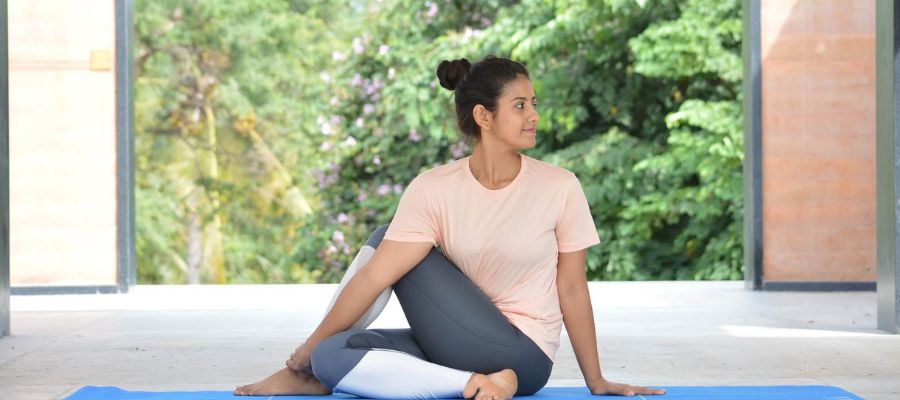
Read this to Learn more about Arhda Matsyendrasana.
Benefits:
- Flexes the spine, making it more supple
- Stretches the back muscles
- Releases stiffness in the hips
Aim: Focus on twisting your body around equally on both sides.
Tips:
- Twist only as much as you are comfortable with.
- You can sit on a cushion to lift your lower back as you twist.
9. Gomukhasana (Cow face pose)
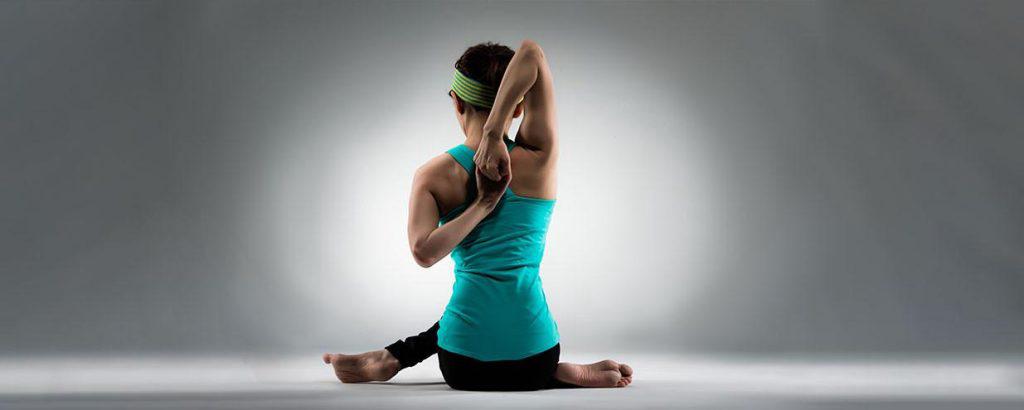
Read this for steps to practice the asana.
Benefits: To know more about Gomukhasana Click here.
- Elongates the spine, correcting posture (bad posture is a major cause of back pain)
- Strengthens the back and hip muscles
Aim: Try to get your hands to meet at the back and maintain this posture as long as you can without straining yourself.
Tip: It is alright even if both hands are not able to meet at the back. It will come over time with practice.
According to a study, yoga is at least as good as physical therapy in dealing with low back pain as in sciatica.
Simple sciatica exercises
Apart from yoga for sciatica, you may practice some of these simple exercises for relief from sciatica.
I. Leg over knee exercise
Lie on your back, with your knees bent and your feet placed flat on the yoga mat. Lift your right foot and place your right ankle over your left thigh. Push your knee slightly downwards for 5 seconds at a time. Do this 3-4 times as per your comfort. Repeat with the other leg as well.
II. Full body stretch
Lie down on your back with your hands stretched straight above your head and legs stretched straight with your toes pointing forward. Stretch your hands and legs in opposite directions. Relax. Repeat 4-5 times.
III. Lying-down body twist
Lie on your back, with your knees bent and arms stretched straight to the sides. Move both knees together towards the right while moving your torso and face towards the left. Allow the top and bottom parts of your body to stretch in opposite directions. Maintain for about 15 seconds and regain your original position. Repeat with the other side.
Yoga always works best when you follow it up with pranayama and meditation.
3 tips to prevent sciatica
- Ensure that you take adequate rest not only when you are in the middle of a sciatica episode but also after the episode is over. Don’t overwork yourself, especially in terms of excessive standing or lifting weights.
- Those practicing yoga for sciatica for seniors may modify poses as needed, and take breaks when necessary to avoid exacerbating the pain.
- Low-impact exercises like walking and water exercises like water aerobics and swimming can also help prevent flare-ups.
Yoga poses to avoid when you have sciatica
Most of the seated and standing forward bending asanas like Hastapadasana (Standing Forward Bend), as well as any asana that puts pressure on the lower back such as Sarvangasana (Shoulder Stand) should be avoided, as they can cause further strain on the pelvis and lower back. It is crucial to listen to your body while practicing sciatica stretches. Avoid any posture that causes discomfort or pain. Always wait for the sciatica episodes to end and practice yoga for sciatica only after consulting your doctor.
A qualified yoga teacher can provide modifications or alternate poses to accommodate any limitations or injuries.
V. Naresh Kumar, a school teacher, from Andhra Pradesh shares, “After doing the Sri Sri Yoga program, my sciatica pain, neck pain, and body pain vanished away.” Would you not like to experience the benefits of yoga for sciatica for yourself?
Join the Sri Sri Yoga program
Conclusion
In conclusion, practicing yoga for sciatica pain can provide many benefits. By incorporating these exercises and stretches into your routine, you can help alleviate pain, improve mobility, and prevent future episodes of sciatica. Remember that yoga is not a substitute for medicine. After consulting your healthcare professional and a trained yoga teacher, ensure you do stretching and strengthening exercises daily.
Written with inputs from Pramod Timsinaa, Faculty, Sri Sri School of Yoga









